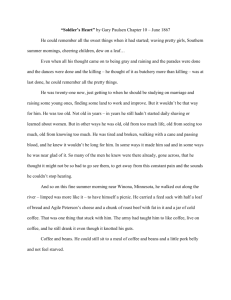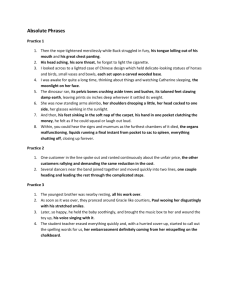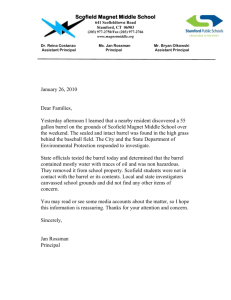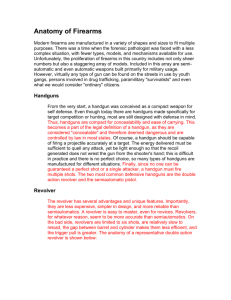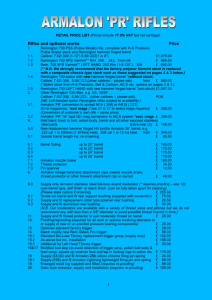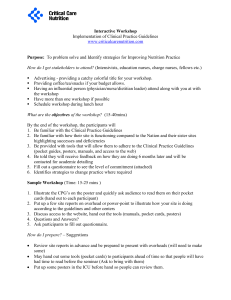4 - American Society of Arms Collectors
advertisement
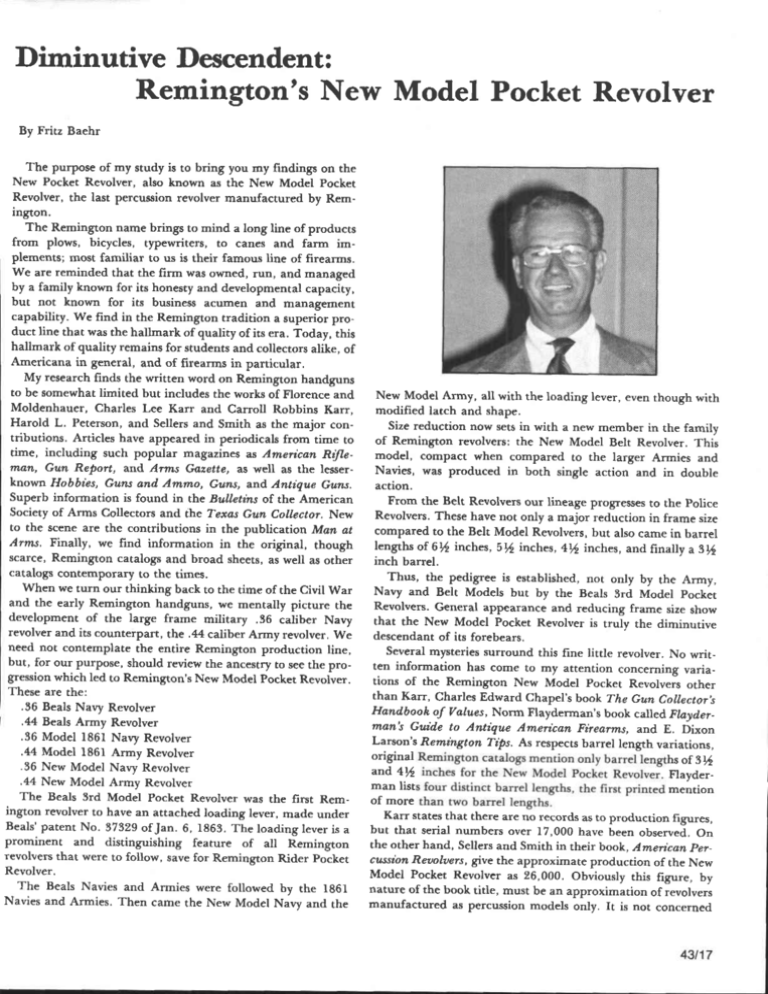
Diminutive Descendent: Remington's New Model Pocket Revolver By Fritz Baehr The purpose of my study is to bring you my findings on the New Pocket Revolver, also known as the New Model Pocket Revolver, the last percussion revolver manufactured by Remington. The Remington name brings to mind a long line of products from plows, bicycles, typewriters, to canes and farm implements; most familiar to us is their famous line of firearms. We are reminded that the firm was owned, run, and managed by a family known for its honesty and developmental capacity, but not known for its business acumen and management capability. We find in the Remington tradition a superior product line that was the hallmark of quality of its era. Today, this hallmark of quality remains for students and collectors alike, of Americana in general, and of firearms in particular. My research finds the written word on Remington handguns to be somewhat limited but includes the works of Florence and Moldenhauer, Charles Lee Karr and Carroll Robbins Karr, Harold L. Peterson, and Sellers and Smith as the major contributions. Articles have appeared in periodicals from time to time, including such popular magazines as American Reyeman, Gun Report, and A m Gazette, as well as the lesserknown Hobbies, Guns and Ammo, Guns, and Antique Gzcns. Superb information is found in the Bulletim of the American Society of Arms Collectors and the Texas Gun Collector. New to the scene are the contributions in the publication Man at Arms. Finally, we find information in the original, though scarce, Remington catalogs and broad sheets, as well as other catalogs contemporary to the times. When we turn our thinking back to the time of the Civil War and the early Remington handguns, we mentally picture the development of the large frame military .56 caliber Navy revolver and its counterpart, the -44caliber Army revolver. We need not contemplate the entire Remington production line, but, for our purpose, should review the ancestry to see the progression which led to Remington's New Model Pocket Revolver. These are the: .36 Beals Navy Revolver 1 .44 Beals Army Revolver .36 Model 1861 Navy Revolver .44 Model 1861 Army Revolver .36 New Model Navy Revolver .44 New Model Army Revolver The Beals 3rd Model Pocket Revolver was the first Remington revolver to have an attached loading lever, made under Beals' patent No. 37529 of Jan. 6, 1865. The loading lever is a prominent and distinguishing feature of all Remington revolvers that were to follow, save for Remington Rider Pocket Revolver. The Beals Navies and Armies were followed by the 1861 Navies and Armies. Then came the New Model Navy and the New Model Army, all with the loading lever, even though with modified latch and shape. Size reduction now sets in with a new member in the family of Remington revolvers: the New Model Belt Revolver. This model, compact when compared to the larger Armies and Navies, was produced in both single action and in double action. From the Belt Revolvers our lineage progresses to the Police Revolvers. These have not only a major reduction in frame size compared to the Belt Model Revolvers, but also came in barrel lengths of 6% inches, 5 % inches, 4% inches, and finally a 3% inch barrel. Thus, the pedigree is established, not only by the Army, Navy and Belt Models but by the Beals 3rd Model Pocket Revolvers. General appearance and reducing frame size show that the New Model Pocket Revolver is truly the diminutive descendant of its forebears. Several mysteries surround this fine little revolver. No written information has come to my attention concerning variations of the Remington New Model Pocket Revolvers other than K ~ I TCharles , Edward Chapel's book The Gun Collector's Handbook of Values, Norm Flayderman's book called Flayderman's Guide to Antique Amen'can Firearms, and E . Dixon Larson's Remington Tips. As respects barrel length variations, original Remington catalogs mention only barrel lengths of 3 M and 434 inches for the New Model Pocket Revolver. Flayderman lists four distinct barrel lengths, the first printed mention of more than two barrel lengths. Karr states that there are no records as to production figures, but that serial numbers over 17,000 have been observed. On the other hand, Sellers and Smith in their book, American Percussion Revolvers, give the approximate production of the New Model Pocket Revolver as 26,000. Obviously this figure, by nature of the book title, must be an approximation of revolvers manufactured as percussion models only. It is not concerned with the cartridge conversions. Therefore, we seek a more accurate production figure for both percussion and conversion models. Flayderman lists only one barrel address, that showing only two patent dates; we shall see that there is more than one barrel address on the Remington New Model Pocket Revolvers. Shape of percussion cylinder nipple wells leads to other variations, not touched upon in known writings. Hammer shape variation is not discussed in any of the writings, nor is interchangeability of percussion and cartridge cylinders in the same revolver. My intent here is to discuss the variations of the Remington New Model Pocket Revolver. Gratefully, I acknowledge those who gave me the nucleus for this article by completing over 100 questionnaires. We all know that 100 questionaires does not produce what the statistician calls a truly representative sample from what was a production of a minimum of 17,000 revolvers. However, in light of an unknown rate of survival, and not knowing the location of all surviving specimens, permit me to bring to you my observations from my meager sampling. It is estimated that Remington produced and marketed their New Pocket Revolver from 1863 to 1888. Remington's Revised Price Lbt dated June 1, 1866, describes the New Pocket Revolver in bore of 31/100th of an inch with barrel lengths of 3% inches and 4% inches. As late as the 1878 catalog, we find the same model, originally percussion, adapted to fixed metallic cartridges. Therefore, we have two distinct models of the same handgun, percussion and cartridge. It may be probably, then, that any previous estimates of production were not concerned with both percussions and the conversions or alterations. The date manufacture began and ended for percussion models, and the date manufacturer began and ended for conversions is still unclear. Since some specimens of the New Pocket Revolver are seen with both conversion cylinders and with the original percussion cylinders, we stand on steady ground that estimates previously made in the 17,000 to 26,000 production range may give way to even higher estimates. My data reveals serial numbers in the 30,000 range and in 40,000 range and, surprisingly, even with serial numbers in the 100,000 range. Because of my small sample and the presumed relatively low survival rate, it may be too bold to presume that production ran in excess of 100,000 pistols. However, the fact remains that my respondents have examined pistols showing serial numbers in excess of 100,000. From this may we then assume production of over 100,000? I see no validity for not supporting the idea. As students of this New Model Pocket Revolver, we are concerned with such design features and variations as finish, barrel length, difference in hammer shape, cylinder shape, patent date variation in the barrel address, grip material, and whether any such differences appear with any noticeable repetition within the serial number ranges. Therefore, it might be well to examine these many variables in some logical breakdown by category. In our breakdown, we must first recognize that the barrel address was found with two different dates: the single patent date addreas of September 14, 1858, and the double date patent address showing both September 14, 1858, and March 17, 1865. We may further delineate into two ignition systems: percussion and conversion or factory alteration to cartridge. Then, contrary to Remington cataloga and other publications, there are not two barrel lengths, but four barrel lengths encountered with frequency. Barrel lengths reported in early publications and Remington catalogs as 5% inches and 434 inches. However, the photos that follow will show some organization helpful to anyone with more than just a casual interest in the final stage of Remington percussion revolvers. port, though not by number of specimens examined. Remington romance gives us one general rule of thumb to follow when examining Remington handguns: that rule is that there is no rule. Variation abounds; contradiction flourishes. For a price, Remington would supply whatever a buyer wanted, so the collector-student finds lack of orderliness. However, the tables that follow will show differences and variations, out of which we may find some organization helpful to anyone with more than just a casual interest in the final stage of Remington percussion revolvers. In conclusion, previously unknown facts are learned when we zero in on one particular model by a manufacturer and examine that model in detail. We may uncover trivia, but the new information should prove helpful to novice and experienced collector alike. This is not to say that these subtle differences make any drastic change in the value of a particular handgun: knowledge is increased, enhanced and happily shared with others, which truly is the legacy generously passed on to me by the dean of Remington students and collectors, Karl F. Moldenhauer . A SUMMARY OF T H E NUMRERS GAME 3 1/B" 9%" 4" 4%" Ptrc. Conv. Perc. Conv. Perc. Conv. Perc. Canv. Single Date 4 6 2 7 1 1 4 S 9 Double Date 1 15 8 - - 2 1 All Braw Frame 4 S - - - - Iron Frame 21 3 16 19 - - 5 4 O v a l Wells 1 6 3 - 9 - 1 Rectangular Wells 8 11 - 1 4 Thick Hammer 2 4 7 1 2 1 Slender Hammer 22 9 11 12 9 - 3 3 Etched 2 - - - Engraved 2 - 6 - Walnut 1 1 3 1 9 7 4 1 3 Rcmewood 1 1 8 7 - - 4 1 2 - - Ebony Ivory 3 - 3 - - - - Pearl 2 Blue 2 0 2 1 7 7 3 S Nickel 2 1 2 7 3 Silver 1 1 9 - - 1 2-Tone 11 3 2 1 1 1 Caned 1 - Pipe Canting - 1 1 + - - - - - I - - - A - - - Remington -31 New Model Pocket Revolver with 3%"Barwith 3%" Barrel, rel, Oval Wells, Slender Hammer. Rectangular Wells, Slender Hammer. . and with 3%" Barrel, Rectangular Wella, Slender Hammer. ... .. Remington .32 Conversion N e w Model Pocket with 5%" Barrel, Slender Hammer. with 9%" Barrel, Thick Hammer. Remington .91 New Model Pocket with scarce 4" Barrel, Oval Wells, Slender Hammer. ... Remington -31 New Model Pocket with 4%" Barrel, Rectangular Welle, Thick Hammer. Remington .I12 Conversion New Model Pocket with 4%" Barrel, Slender Hammcr. Remington .31 New Model Pocket with 4%" Barrel, Rectangular Wells, Slender Hammer. ..., . Single ramrod pipe Deringer No. 29 1812 U.S.Nevy belt book model J. Henry martial piutol. Approximately 460 were delivered in 1813 and 1814. Only one flintlock and one convernion are known to have aurvived.


